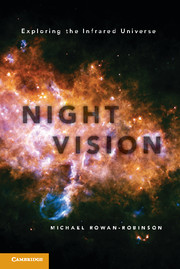Book contents
- Frontmatter
- Contents
- Preface
- 1 Introduction
- 2 William Herschel Opens Up the Invisible Universe
- 3 1800–1950
- 4 Dying Stars Shrouded in Dust and Stars Being Born
- 5 Birth of Submillimetre Astronomy
- 6 The Cosmic Microwave Background, Echo of the Big Bang
- 7 The Infrared Astronomical Satellite and the Opening Up of Extragalactic Infrared Astronomy
- 8 The Cosmic Background Explorer and the Ripples, the Wilkinson Microwave Anisotropy Probe and Dark Energy
- 9 Giant Ground-Based Near-Infrared and Submillimetre Telescopes
- 10 The Infrared Space Observatory and the Spitzer Space Telescope
- 11 Our Solar System’s Dusty Debris Disk and the Search for Exoplanets
- 12 The Future
- Epilogue
- Notes
- Credits for Illustrations
- Glossary
- Further Reading
- Bibliography
- Name Index
- Subject Index
7 - The Infrared Astronomical Satellite and the Opening Up of Extragalactic Infrared Astronomy
Starbursts and Active Galactic Nuclei
Published online by Cambridge University Press: 05 March 2013
- Frontmatter
- Contents
- Preface
- 1 Introduction
- 2 William Herschel Opens Up the Invisible Universe
- 3 1800–1950
- 4 Dying Stars Shrouded in Dust and Stars Being Born
- 5 Birth of Submillimetre Astronomy
- 6 The Cosmic Microwave Background, Echo of the Big Bang
- 7 The Infrared Astronomical Satellite and the Opening Up of Extragalactic Infrared Astronomy
- 8 The Cosmic Background Explorer and the Ripples, the Wilkinson Microwave Anisotropy Probe and Dark Energy
- 9 Giant Ground-Based Near-Infrared and Submillimetre Telescopes
- 10 The Infrared Space Observatory and the Spitzer Space Telescope
- 11 Our Solar System’s Dusty Debris Disk and the Search for Exoplanets
- 12 The Future
- Epilogue
- Notes
- Credits for Illustrations
- Glossary
- Further Reading
- Bibliography
- Name Index
- Subject Index
Summary
The launch of the Infrared Astronomical Satellite (IRAS) on 25 January 1983 was a very exciting moment in the history of infrared astronomy. It had been designed to survey the whole sky at far-infrared wavelengths between 10 and 100 microns. When the helium coolant ran out ten months later on 22 November, IRAS had surveyed 96% of the sky. Over the next few years there were a string of discoveries that still comprise the core of our knowledge of the dusty universe: the zodiacal dust bands, the link between Apollo asteroids and comets, the infrared ‘cirrus’, debris disks and protoplanetary systems, ultraluminous and hyperluminous infrared galaxies, dust tori around active galactic nuclei, young stellar objects and ‘protostars’, and the origin of our Galaxy’s motion through the cosmic frame.
The IRAS Story
During the 1970s, Dutch astronomers had been exploring the concept of a dedicated infrared satellite and managed to get U.S. astronomers and NASA interested in the idea, with the latter proposing that the wavelength range be extended to 100 microns. In 1975, Nancy Boggess, head of infrared astronomy at NASA, assembled a group of infrared astronomers at Snowmass, a ski resort in Colorado. To their surprise, she announced that NASA intended to build a space facility for infrared astronomy and to operate it from the instrument bay of the space shuttle. They had even given it a name, the Shuttle Infrared Telescope Facility, or SIRTF. The astronomers argued instead for a smaller survey satellite in Earth orbit which would map the whole sky in a few weeks, a proposal that Neugebauer and others had originally made in 1971. The survey satellite concept did not make much progress until the Dutch began to propose a joint U.S.-Dutch mission. In 1976, on the initiative of the Dutch astronomers, the United Kingdom was also invited to join what became the Infrared Astronomical Satellite, or IRAS.
- Type
- Chapter
- Information
- Night VisionExploring the Infrared Universe, pp. 84 - 108Publisher: Cambridge University PressPrint publication year: 2013



